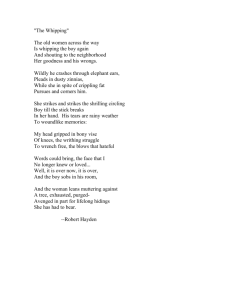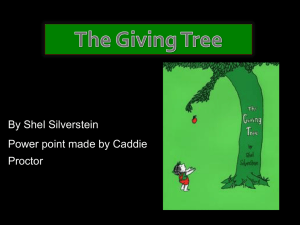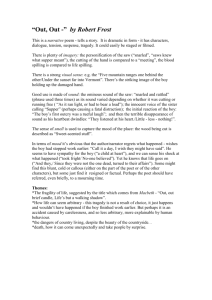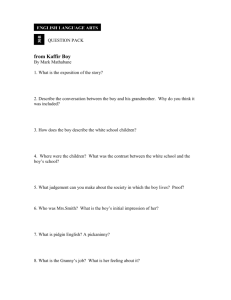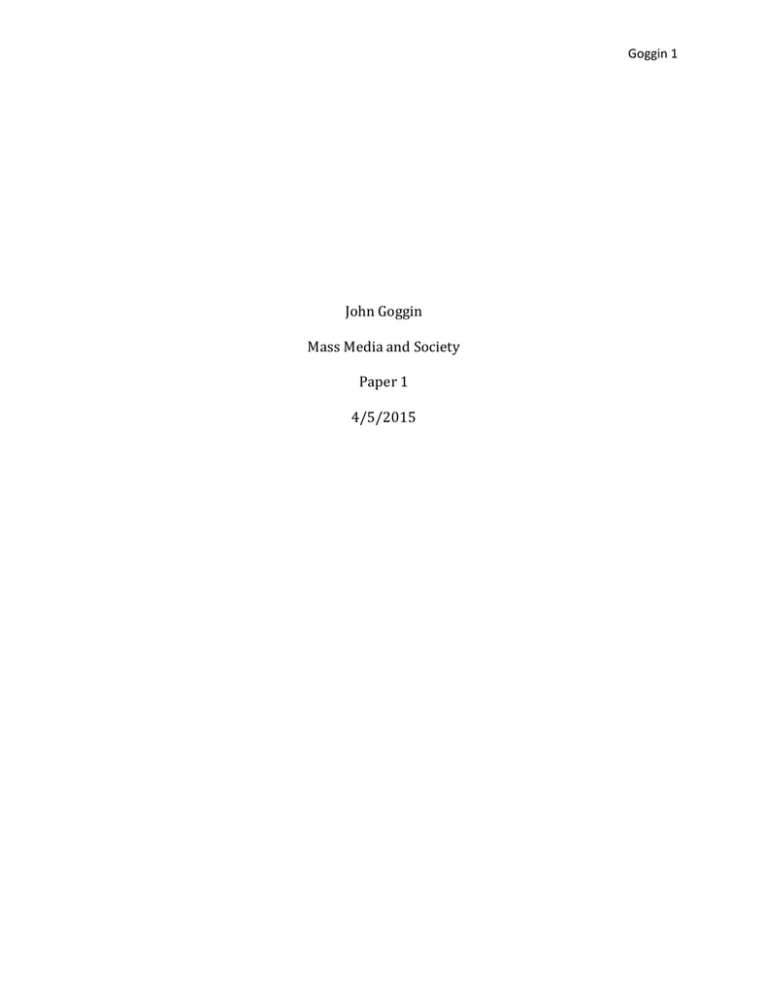
Goggin 1
John Goggin
Mass Media and Society
Paper 1
4/5/2015
Goggin 2
Abstract
Sex has been a sales tactic for decades, selling everything from movies to medication. There
are many ways in which sex is used to sell products such as suggestive imagery, audible
cues and identity tactics. The tactic I want to address is the bad boy complex and how it is
used in mass media. Companies such as Tom Ford, Harley Davidson and Axe glamourize
this identity in order to convince men they need their products. The companies send
promote that there products will make you tough, sexy, irresistible to women, rebellious
and other bad boy characteristics. Although this is nothing more than a manipulation of the
masses, it is fascinating that companies use a looking glass self-approach to sell their
products to individual who want to be more “cool”. In reality Tom Ford is overpriced
clothing, Harleys do not make you tougher and Axe certainly does not bring flocks of
women to your door step. What the products actually do is irrelevant; what the consumer
thinks they do or what these products “say” about the consumer is what drives sales. As we
look around town it is apparent that this tactic is working all too well. My research hopes to
answer why this tactic works and what exactly do both men and women find appealing
about this approach to selling an identity.
Goggin 3
Last semester I found a show named Californication that is about a bad boy, sex
addict, alcoholic, drug abusive, womanizing Los Angeles writer who renders women
powerless to his charm. How is it possible that the last man society says a women should
want is so irresistible? According to a study done by the University of Georgia, sexual
imagery is becoming more and more prevalent in magazine ads. The study shows that,
“Those most often using sexual imagery in advertising were health and hygiene at 38
percent; beauty, 36 percent; drugs and medicine, 29 percent; clothing, 27 percent; travel,
23 percent; and entertainment, 21 percent.” It was also found that one third of alcohol
advertisements contain sexual imagery. It is no secret that sex sells and that brands,
movies, TV shows, and companies often use it as a driver for sales. Weather it is a halfnaked women holding a product or Matthew McCaughey speaking in a low monotone voice
driving an unreliable car; sexy things will get our attention. The bad boy complex is just one
of these sex tactics that uses irresistible rebellious male figures to make sales. These bad
boy figures tend to be confident, dominant, sarcastic rule breakers who show little
weakness or desire to conform to societal norms. My goal is to better understand the
characteristics and qualities that make the bad boy so desirable. With that I can understand
how those qualities should be used to generate sales. Through focus group interviews with
7 undergraduate Rollins College students, I was able to breakdown exactly what is so
captivating about these rebellious figures to young adult men and women.
I began with a content analysis of 17 movie and television characters that are
notorious bad boys from the 1980’s to present. I used google to search for some of the most
iconic bad boys in pop culture on websites like IMDB, GQ, People and All Womens Talk. By
choosing characters with major roles from high grossing movies and TV shows I was able
Goggin 4
to compile a list of some of the most recognized and beloved bad boy portrayals in pop
culture. I then went through websites such as eHarmony, Psychology Today and Babble to
find what personality traits embody the bad boy image and what is so appealing about it. I
broke down the 12 character traits into 3 categories including appearance, lifestyle and
personality traits. In an excel spreadsheet I listed the characters and the 12 character traits
to see what are the most prevalent attributes of a bad boy. The characteristics that were
found in over 80% of the movies were physically attractive, involved in criminal activity,
driven by sex, irresistible to women and self-centered. After this content analysis I looked
at these characters and thought how could we possibly obsess over these individuals? On
paper these individuals are self-centered, criminals, driven by lust and manipulative in
nature. With a focus group interview I hoped to answer why we find these individuals so
appealing to the point of desire or idolization.
I chose to use focus group interviews asking open ended questions and allowing
participants to explain what they find appealing about the bad boy complex. I targeted
Rollins College undergraduates between the ages of 19-22 because I wanted to know what
young adults thought of the bad boy complex as a strategy. I conducted 2 different
interviews around 40 minutes in length and split by gender. The reason I split up the
genders was so that the individuals would feel more comfortable answering the questions
honestly around individuals who are more likely to understand their opinions. I believe
this decision broke down social pressure barriers and allowed me to gather more accurate
data. According to Rosaline Barbour and Jenny Kitzinger in their book Developing Focus
Group Research: Politics, Theory and Practice; intermixing genders between researcher and
participants can cause inaccurate data when discussing taboo topics. Splitting up the
Goggin 5
participants by gender was necessary for a topic such as attraction across gender or
idolization of the same gender. Although there was no way for me to be a female researcher
I tried to keep the topic up beat, relaxed and fun in hopes that the female participants
would feel more comfortable sharing sensitive information.
I chose to ask only three questions so that the participants could run the discussion
and hopefully reveal some information I didn’t think of. The first question was, “who do
you think of when you think of a bad boy?” The reasoning for this question was I wanted to
see who they are thinking of and if the personality types differ from mine. The girls tended
to think of more rock and roll mannered individuals like James Hunt in Rush or Stacee Jaxx
from Rock of Ages. The males thought of the more violent, criminally active, angry bad boys
such as Jordan Belford from Wolf of Wall Street or Al Pacino characters. This was an
element that I didn’t think of until I began the second interview and may turn out to be a
very important element to my study. I will dive deeper into this during my in depth
interview. I did find that the participants chose some of the same actors as I had but in
different movies, such as Leonardo DiCaprio, Ryan Gosling and Bradley Cooper.
The second question was, “What characteristics does a bad boy possess?” I
intentionally asked “what DOES the bad boy possess” instead of “what characteristics DO
YOU THINK a bad boy possesses.” The reason for this was I wanted to get a societal view
more than an individual view. I wanted to know how the participants think society
constructs the bad boy. My fear was that if I asked “how does society construct the bad
boy”, the participants may disconnect personal opinion too much and keep the discussion
surface level. This question structure falls somewhere between full separation and
individualistic opinion. The participants answers to this question surprised me because
Goggin 6
their view of the bad boy was completely different than mine. The women said that bad
boys tend to be confident, mysterious, well dressed, intimidating and independent. The
men said things such as confident, swagger, irresistible, blunt and funny. The worst
characteristics mentioned during the focus group was sarcastic and hated, loved or both.
(Meaning either people love the bad boy, hate the bad boy or both love and hate him such
as a women in love with the bad boy who treats her poorly) Not once did someone say selfcentered, angry, alone, criminal or suppressive. Almost every characteristic mentioned was
an attractive trait in a person. Many of us would like to be known as confident,
independent, funny and irresistible. None of these traits however make someone a literal
bad boy (Such as a criminal). These traits sum up someone with a bad boy mentality minus
the rule breaking even though the characters mentioned for the most part are all literal bad
boys (Drug users, criminals, thief’s, rule breakers, etc.).
The third and final question was, “Why would you want to be or be with a bad boy?”
Two out of the three males said they have no interest in being a bad boy and two out of the
four girls said they had no interest in being with a bad boy. I said, “Ok, are there things that
you do like about the bad boy complex even though you don’t want to be or be with a bad
boy?” The mood immediately changed for both interview groups. The female group began
to explain why these individuals confidence is so appealing, why their demeanor is so sexy
and why their independence is so captivating. The male group began to state how the bad
boys get the attractive girls, they keep their cool in scary situations and how nice guys
finish last. Even though so much of the group said they do not want to be or be with a bad
boy they still find them incredibly appealing. The female group got very excited as they
began discussing amongst themselves what is so sexy about these men. Their postures all
Goggin 7
changed to be more relaxed and animated, they all seemed to get this excited look in their
eyes and their vocal volume increased pretty significantly. They repetitively used the word
sexy when describing the bad boy mannerisms or things that the bad boy does such as
drive a motorcycle. The male group took a more relaxed posture, spoke with more
confidence and began explaining essentially why it would be cool to be the bad boy even
though most of them stated earlier why they wouldn’t. The males were more interested in
discussing the fantasy of being the bad boy. They mentioned the women they would be
with, how they would look, the car they would drive (All said 60’s-70’s muscle cars) and the
men that they think hold these attributes. There was excitement between the males as one
person would mention something that would be “cool” as the others would chime in with
agreement and usually laughter. Towards the end of the discussion the male group began
to discuss the pressures of the male identity which was interesting to hear. This topic came
back to why they would not want to be a bad boy. Essentially they said why should they
have to act like a heartless bad boy to be cool. At the end of the day the male group all
agreed that many guys who possess the bad boy image often seem as if they are hiding
from some under laying feelings or trying to fill a void because they are not man enough to
embrace their issues. Clyde Franklins book The Changing Definition of Masculinity
addresses this same topic. Franklin states that there is a pressure for the male role that is
slowly changing to be more sensitive and warm because it shows its own form of
confidence and self-esteem. I was pretty taken back by this swift shift in demeanor
between both groups and how engaged they became in the conversation as opposed to the
earlier questions. Both groups seemed to really enjoy discussing why they might want to be
or be with a bad boy even though most of them stated they didn’t want to. I think the
Goggin 8
explanation behind this is possibly an intimidation and comfort factor for the females. For
the men I can imagine it is self-satisfaction, fear of being a bad boy and what comes along
with the bad boy lifestyle. It seemed as if the appeal of the bad boy in my focus groups was
more of a fantasy fascination than a desired reality which is a major element to understand
when targeting in audience in media.
One of the major and shocking themes that I found was the emphasis on positive
traits and the neglect of the negative ones. This would explain why the marketing tactic is
so successful. Without seeing the cocaine on the table or the women with a broken heart in
the print ad it is easy to just think of the positive bad boy traits. This concept branches off
into the fantasy vs reality aspect of the bad boy complex in question 3. The participants
make it very apparent that most of them would not want to be or be with a bad boy but
they also find them very attractive and seductive in nature. The participant’s demeanor
immediately changed when we began discussing the topic of fantasy. I believe this suggests
that there is much more of a fantasy appeal to the image than a desired reality. The girls
made it clear that they would have a problem trusting and feeling comfortable with a bad
boy. The men said they feel resistant to becoming a bad boy because it is against their
moral code, not who they truly are and they are afraid of what the lifestyle might bring.
When we see these portrayals in movies, print ads and commercials however we enjoy
fantasizing about being or being with a bad boy because it sounds so adventurous, sexy and
exhilarating. Erlich’s explained in his article Reality, fantasy, and adolescence how we
embrace fantasy as an ego related exhilaration where we disconnect the self from the
reality and enjoy the thought of being an alternate individual without ever being another
individual. (Erlich) For many of us the fascination stops there. It is tried and true that we
Goggin 9
buy products that are marketed as a bad boy product because we like the fantasy and
image of it even though we do not want to fully replicate the ideology.
Goggin 10
Work Cited
Kitzinger, Jenny, and Rosaline S. Barbour. "3." Developing Focus Group Research: Politics,
Theory, and Practice. London: SAGE Publications, 1999. 57. Print.
Franklin, Clyde W. The Changing Definition of Masculinity. New York: Plenum. Print.
Erlich, H S. "Reality, Fantasy, andadolescence." Psychoanal study child vol. 48, (1993):209.


